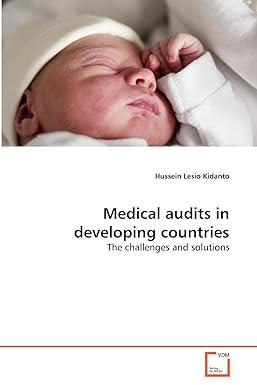Question
Special Order Decision Robin Company produces a light-weight travel raincoat with the following unit cost: Direct materials P4.00 Direct labor P1.00 Variable overhead P1.75 Fixed
- Special Order Decision
Robin Company produces a light-weight travel raincoat with the following unit cost:
Direct materials P4.00
Direct labor P1.00
Variable overhead P1.75
Fixed overhead P2.00
Unit cost P8.75
While production capacity is 200,000 units per year, Robin expects to produce only 170,000 raincoats for the coming year. The fixed selling costs total P85,000 per year, and variable selling costs are P0.50 per unit sold. The raincoats normally sell for P12 each.
At the beginning of the year, a customer form a geographic region outside the area normally served by the company offered to buy 20,000 raincoats for P8 each. The customer would pay all transportation costs, and there would be no variable selling costs.
Required:
Should the company accept the order? Provide both qualitative and quantitative justification for your decision. Assume that no other orders are expected beyond the regular business and the special order.
- Optimal Mix
Two type of gears are produced: Y and Z. Gear Y has a unit contribution margin of P200, and Gear Z has a unit contribution margin of P400. Gear Y uses two hours of grinding time, and Gear Z uses five hours of grinding time. There are 200 hours of grinding time available per week. This is the only constraint.
Required:
- Is the grinding constraint an internal constraint or external constraint?
- Determine the optimal mix. What is the total contribution margin?
- Suppose that there is additional demand constraint: Market conditions will allow the sale of only 80 units of each gear. Now, what is the optimal mix? The total contribution margin per week?
- Special Order Decision
Robin Company produces a light-weight travel raincoat with the following unit cost:
Direct materials P4.00
Direct labor P1.00
Variable overhead P1.75
Fixed overhead P2.00
Unit cost P8.75
While production capacity is 200,000 units per year, Robin expects to produce only 170,000 raincoats for the coming year. The fixed selling costs total P85,000 per year, and variable selling costs are P0.50 per unit sold. The raincoats normally sell for P12 each.
At the beginning of the year, a customer form a geographic region outside the area normally served by the company offered to buy 20,000 raincoats for P8 each. The customer would pay all transportation costs, and there would be no variable selling costs.
Required:
Should the company accept the order? Provide both qualitative and quantitative justification for your decision. Assume that no other orders are expected beyond the regular business and the special order.
- Optimal Mix
Two type of gears are produced: Y and Z. Gear Y has a unit contribution margin of P200, and Gear Z has a unit contribution margin of P400. Gear Y uses two hours of grinding time, and Gear Z uses five hours of grinding time. There are 200 hours of grinding time available per week. This is the only constraint.
Required:
- Is the grinding constraint an internal constraint or external constraint?
- Determine the optimal mix. What is the total contribution margin?
- Suppose that there is additional demand constraint: Market conditions will allow the sale of only 80 units of each gear. Now, what is the optimal mix? The total contribution margin per week?
Step by Step Solution
There are 3 Steps involved in it
Step: 1

Get Instant Access to Expert-Tailored Solutions
See step-by-step solutions with expert insights and AI powered tools for academic success
Step: 2

Step: 3

Ace Your Homework with AI
Get the answers you need in no time with our AI-driven, step-by-step assistance
Get Started


